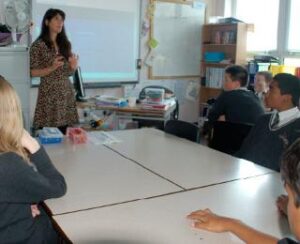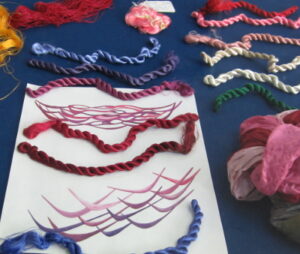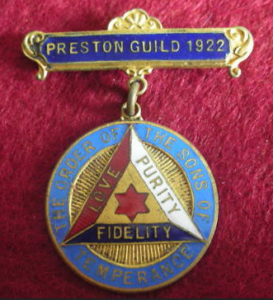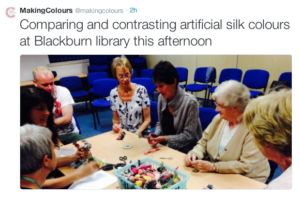Why did the story of artificial silk need to be told?
Northern manufacturing industries have shaped its memories and left a lasting heritage. There are still many hidden stories.
A short film created by Jemima Louise Pollitt and Nathan Staddon drew on interview material from artificial silk workers
As the gap widens between the closing of textile factories and the present day, it is important to celebrate the unique experiences and perspectives of the people who came to England to work in the artificial silk (viscose) industry. Countries include Belgium, India, Lithuania, Pakistan, Poland, the Ukraine and the West Indies.
Many Italian prisoners of war settled in Preston. The Fons character in the novel is a second generation Italian. Characters in the fictional story from Pakistan to Preston reflect these and already resident communities. Roman Urdu (phonetics) and Lancashire dialect feature in the book.

Pupils at Lark Hill Sixth Form produced some inspiring creative writing. Media students at Penwortham Girls High School filmed the visit as a way of welcoming their new intake of students.
Pupils at Fulwood Academy asked new and challenging questions as well as old chestnuts like, How money do you make? and How famous are you?

A four-month exhibition was launched at the People’s History Museum on the Salford-Manchester border.

ONE OF MANY TIMELINES
1939 the gates of Courtaulds, an artificial silk factory, opened in Preston, Lancashire, on the eve of the Second World War. Employing 3,500 workers, those same gates closed 41 years later.
1947 Jean Crossthwaite and Terry Boyle began working in the colour laboratory.
1954 Jean Crossthwaite and Terry Boyle got married.
1956 Jean left her job in the laboratory because she was was pregnant with her first child – expected of women at the time.
1950 – 1980 stories about textile shades and shade naming emerged… spillages of bright red pigment, a fire, the humour and resilience of thousands of factory workers on a single Lancashire manufacturing site.
1972 Guild feature in the story, including Avenham Park just after Concorde has made a noisy and memorable flyover.
1980 the gates of Courtaulds were shut, with the loss of 2,600 jobs.
31st August 2012 LightNight at the Museum of Lancashire in Preston. Refreshments included burfi (fudge) from the sweet shop round the corner in Acregate Lane, the setting for the novel, and huge ‘squashed ant’ Eccles cakes (pastry and sugared raisins).
3rd September 2012 Preston Guild (the previous Guild was 1992). Miller Park was host to Preston born animator Nick Park, creator of Wallace and Gromit, and a rang group from Blackburn displaying colourful seed patterns on Top Walk where Victorians promenaded on Sunday. Performances by local poets and a reading from the novel for people lounging on deckchairs in the Preston sunshine.
12th September 2012 Gilly (John Gilmore, BBC Radio Lancashire) broadcasted live for three hours from Walton-le-Dale primary school near Preston. Listeners heard how pupils and teachers have been inspired by the Guild, regional Cultural Olympiad celebrations and the story. Pupils made painted tiles with shields of the Green Guild, the Merchants’ Guild and the People’s Guild.

“We all had a fantastic day and to be honest the week and a half has been one of the best whole school projects we’ve done. It’s so inspiring for the children (and us as a staff) to have had the opportunity to work with you. As I mentioned yesterday it’s given me plenty of ideas for continuing themes!” (Jen Douglas, Curriculum Leader, Walton-le-Dale primary school)
22nd September 2012 was Readers and Writers Day at Macclesfield Library in Cheshire. The library manager gave a customised cupcake topped with a tiny icing sugar book to each author. (No photograph available. Cupcake consumed.)
24th November 2012 the co-authors gave a reading from the book Alison and Terry wrote together, from Pakistan to Preston. The T in A.T. Boyle guided the library audience through some of the complex processes in making artificial silk from wood pulp.

He advised us not to spread viscose on hot buttered toast, or in fact anything you plan to eat because it’s the chemical would harm you.
Preston Guild 1972 is the main setting for the fiction book set in a Preston textile factory. Tommy O’Reilly from Preston and Sunehri Saleem from Pakistan are working at an artificial silk factory. As Tommy creates a vibrant new shade that will be made into flags to celebrate the Guild, the bright skein of modern Britain’s origins is gradually untangled.
Many people remarked that, because Preston Guild is such an important local event, they measure their lives in Guilds. Usually occurring every twenty years, there was a blip in 1942 when the Second World War caused a 10-year delay. That Guild was eventually staged in 1952.
In 1179, King Henry II granted Preston the right to have a Guild Merchant. The Guild was an organisation of traders, craftsmen and merchants that controlled trade in the Lancashire town. Every twenty years the Guild met to update its records, admit new members, and deal with people falsely claiming the right to trade. Gatherings were a good excuse to hold processions.

After the Guild lost its power in 1790, the Guild Merchant survived because the celebrations had grown into prestigious social occasions.
Preston Guild is the only one of its kind flourishing today. Unless it is interrupted, the next Guild will be in 2032.
In the story Tommy makes a new shade for the Guild Mayor in 1972, and forty years later the character anticipates a school visit where he will talk to children about the North’s social and industrial heritage. Terry gave talks in the Northwest during 2012.
24th May 2013 The World Museum Liverpool foyer was decorated with fabrics from around the world for Lifelong Learning week. A talk about how artificial silk was made from the wood pulp in fir trees was aided by an artificial Christmas tree, an incongruous object on a sunny bank holiday in Liverpool.

Preston Mela June 2013 had South Asian classical and Bollywood dance performances at the Flag Market and three princesses on stilts at Preston’s Fish Market.
Manchester Mela July 2013 on Platt Fields Park brought visitors to a paranda stall in the Arts and Crafts tent. Participants chose favourite colours of artificial silk thread then made tassels to attach to their hair. Some things overheard that day:

“These shades look brilliant together.”
“My aunty’s paranda is really old. She washes it every few days. It gets a bit knotted.”
“Let me show you.” (female elder)
“Thank you. Can we take it home?” (10 year-old boy)
10th September 2014 The Blackburn with Darwen trailblazer saw a group of library visitors exploring the shade names of artificial silk produced in Lancashire.

A pair of trousers being worn by one of the participants that had been labelled ‘nougat’ by a shop assistant led us to look more closely at the labels sewn into our garments that day. A sample of the shade wordplay:
clover pink, moss green, sage
olive green, russet, wheat
baby pink, pale coffee, charcoal
dusty turquoise, dusty pink, teal
silver grey, burgundy, buttercup
coral pink, mink brown and heather.
Craft objects made by the participants in Blackburn were attached to the Big-Up Female Boffins banner in the Colours, Community and Chemistry exhibition.
Colours, Community & Chemistry was a 17-week collaboration between regional artists, archivists and scientists at the People’s History Museum. Find out more.